
Hypolimnas is a genus of tropical brush-footed butterflies commonly known as eggflies or diadems. The genus contains approximately 23 species, most of which are found in Africa, Asia, and Oceania. One species, the Danaid eggfly, is noted for its exceptionally wide distribution across five continents; it is the only Hypolimnas species found in the Americas.

Hypolimnas bolina, the great eggfly, common eggfly or in New Zealand the blue moon butterfly is a species of nymphalid butterfly found from Madagascar to Asia and Australia.

Pseuderanthemum variabile is a species of plant in the family Acanthaceae. Its natural habitat is the floor of rainforest or wet eucalyptus forest of northern and eastern Australia, north of Bega, New South Wales. Common names include night and afternoon, pastel flower and love flower.
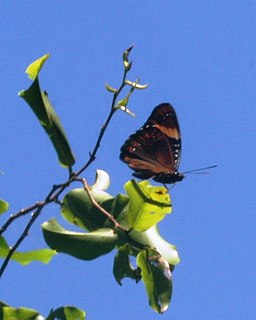
Hypolimnas octocula, the eight-spot butterfly, is a species of eggfly or diadem endemic to several islands and island chains in Oceania, including New Caledonia, Vanuatu and the Mariana Islands.
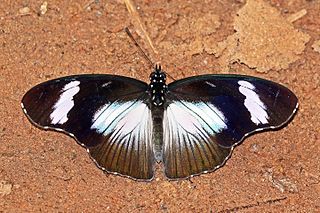
Hypolimnas anthedon, the variable eggfly or variable diadem, is a species of Hypolimnas butterfly found in southern Africa. There are four known subspecies, but it is very variable species with many morphs.

Hypolimnas deceptor, the deceptive eggfly or deceptive diadem, is a species of Hypolimnas butterfly found in southern Africa.

Hypolimnas alimena, the blue-banded eggfly, is a species of butterfly in the family Nymphalidae. It is found in the Solomon Islands, Indonesia, New Guinea and Australia.

Hypolimnas antevorta is a butterfly in the family Nymphalidae. It is found in north-eastern Tanzania. The habitat consists of sub-montane forests at altitudes of about 1,000 m (3,300 ft).
Hypolimnas aubergeri, the Côte d'Ivoire eggfly, is a butterfly in the family Nymphalidae. It is found in Guinea, eastern and central Ivory Coast and possibly Ghana. The habitat consists of forests.
Hypolimnas bartelotti is a butterfly in the family Nymphalidae. It is found from Cameroon to the Democratic Republic of the Congo and in western Uganda.
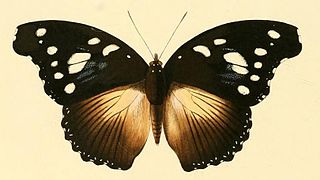
Hypolimnas dinarcha, the large variable diadem or large variable eggfly, is a butterfly in the family Nymphalidae. It is found in Sierra Leone, Liberia, Ivory Coast, Ghana, Nigeria, Cameroon, Gabon, the Republic of the Congo, Angola, the Democratic Republic of the Congo, the Central African Republic, Uganda, Kenya and Tanzania. The habitat consists of heavy lowland forests and secondary forests with a closed canopy.
Hypolimnas macarthuri is a butterfly in the family Nymphalidae. It is found in the Central African Republic.

Hypolimnas mechowi is a butterfly in the family Nymphalidae. It is found in Cameroon, the Republic of the Congo, the Central African Republic and the Democratic Republic of the Congo.

Hypolimnas monteironis, the black-tipped diadem or scarce blue diadem, is a butterfly in the family Nymphalidae. The species was first described by Herbert Druce in 1874. It is found in Nigeria, Cameroon, Gabon, the Republic of the Congo, Angola, the Democratic Republic of the Congo, Uganda, Kenya and Tanzania. The habitat consists of forests.
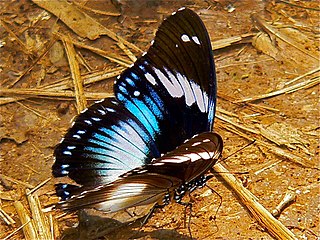
Hypolimnas salmacis, the blue diadem, is a butterfly in the family Nymphalidae. It is found in Sierra Leone, Liberia, Ivory Coast, Ghana, Togo, Benin, Nigeria, Cameroon, Gabon, the Republic of the Congo, Angola, Equatorial Guinea, São Tomé and Príncipe, the DRC, Uganda, Sudan, Ethiopia, Kenya and Tanzania. The habitat consists of secondary forests and disturbed environments.

Hypolimnas usambara, the red spot diadem or Usambara diadem, is a butterfly in the family Nymphalidae. It is found along the coast of Kenya and in Tanzania, from the coast inland to the Usambara Mountains. The habitat consists of primary coastal forests.
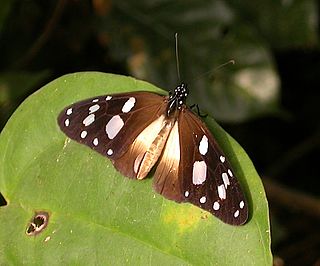
Amauris damocles, the small monk, is a butterfly in the family Nymphalidae. It is found in Senegal, Gambia, Guinea, Burkina Faso, Sierra Leone, Liberia, Ivory Coast, Ghana, Togo, Benin, Nigeria, Cameroon and Tanzania. The habitat consists of dry forests, Guinea savanna and disturbed areas in the rainforest zone.

Hypolimnas antilope, the spotted crow eggfly, is a butterfly of the family Nymphalidae. It is found from Malaya to the Philippines, New Guinea and Australia.
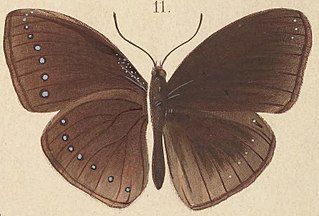
Hypolimnas pithoeca is a butterfly in the family Nymphalidae. It is found in New Guinea.

Hypolimnas pandarus is a butterfly in the family Nymphalidae. The species was first described by Carl Linnaeus in his 1758 10th edition of Systema Naturae.
















